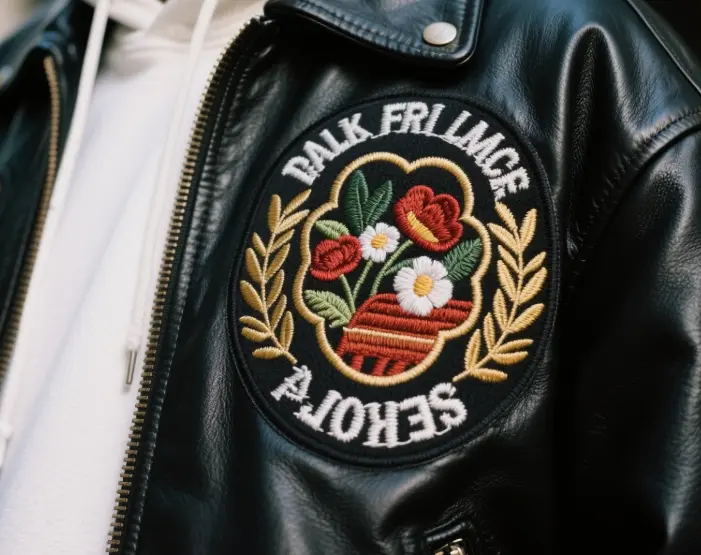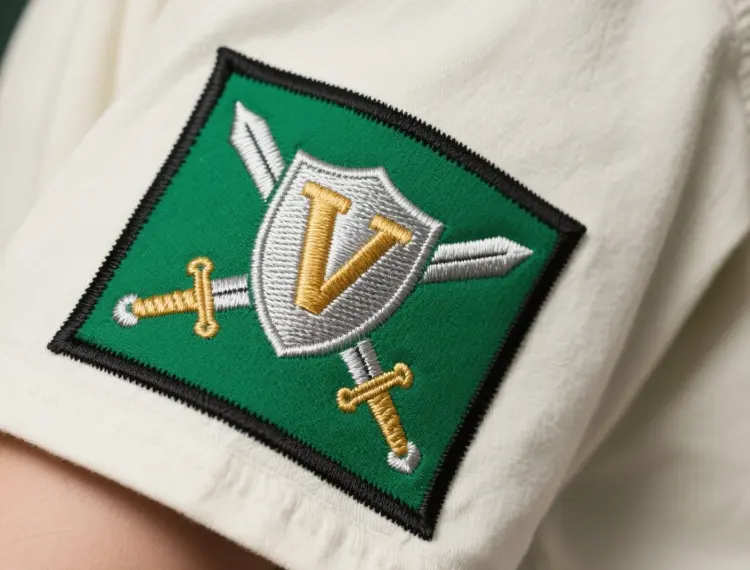When you have a stylish leather jacket and want to add personality and unique style to it by adding some custom embroidered patches, you may think of the easiest way to do it – using iron-on patches. After all, iron-on patches seem so convenient that you just need to use an iron-on hot melt adhesive to attach them to your clothing without the need for tedious sewing. Unfortunately, this practice does not apply to leather and may even damage your clothing. So why are iron on patches and leather incompatible? How can you add patches to leather correctly? This article will give you detailed answers.

Why is the combination of iron on patches and leather not ideal?
First of all, let’s understand how iron on patches work. An iron on patch is a patch with a hot melt adhesive, which is ironed at a high temperature to melt the hot melt and bond firmly to the fabric. It is ideal for more heat-absorbent fabrics like cotton and polyester, which absorb heat efficiently, allowing the hot melt adhesive to melt quickly and bond to the surface. Leather, however, is different.
The special characteristics of leather
Leather is a natural material that is usually durable and flexible, but also relatively smooth and dense. As leather does not have the same fiber structure as fabric, it cannot absorb heat as effectively as fabric, so hot melt adhesives cannot melt and bond firmly to the surface of leather. In addition, the surface of leather has a high oil content, which makes it more difficult for the hot melt adhesive to adhere to the surface of the leather. Therefore, although iron on patches are designed to work on many common materials, leather is clearly out of scope.
Problems caused by high temperatures
In order for the glue for ironing patches to fully melt and adhere to the surface, the iron needs to reach a certain temperature. However, leather is extremely sensitive to high temperatures. Excessive temperatures can cause damage to the surface of the leather, such as burning, distortion and loss of color. In addition, the high temperature may also trigger the overflow of grease on the surface of the leather, resulting in the patch not being able to adhere firmly, and may even leave some partially melted glue lumps, resulting in a “hot iron catastrophe”.
The case for faux leather and nylon
If you think that faux leather or nylon might be a good alternative, then perhaps you need to reconsider. Although these materials look similar to leather, they are equally incapable of withstanding the high temperatures required to iron patches. Faux leather tends to melt at high temperatures, while synthetic fibers such as nylon cannot withstand excessive heat. Attempting to apply iron on patches to these materials can often result in melting of the fabric, peeling of the patch, or even ruining the garment.

How to use patches correctly on leather?
So, since iron on patches and leather are not compatible, how do we add personalized patches to leather or similar materials?
Using traditional sewing methods
The safest and most reliable way to solve this problem is to use traditional sewing methods. Although many people may find sewing patches troublesome, it is actually not as complicated as one might think. All it takes is a needle and some thread to sew the embroidered patch securely onto the surface of the leather. If you are not good at sewing, it is perfectly fine to leave this task to a professional tailor, who will usually do the patch sewing for you at a very reasonable cost.
The advantage of using needle and thread to sew patches is that it ensures that the patch is firmly attached to the surface of the leather, is not affected by high temperatures, and does not suffer from problems such as poor bonding or burning due to the special nature of the fabric.
Choosing the right patch and material
When you decide to use a sewing method, it is important to choose patches that are suitable for leather. Leather is inherently thick and tough, so the back of the patch needs to be of a material that can be sewn securely. There are embroidered patches on the market that are specially designed for leather, and they usually have enough pre-drilled holes on the back to make the sewing process smoother. Choosing a good quality patch that is suitable for leather not only improves the decorative effect, but also ensures longevity.
Ask a professional to do it for you
If you really don’t want to do the sewing yourself, or don’t have enough time or skill to do it, the easiest way is to find a local tailor store. Most tailors will be able to provide you with patch sewing services, and the prices are usually reasonable. Leaving the patches in the hands of professionals will not only ensure that the patches are strong, but will also ensure that the end result is perfect.
Advantages of Traditional Sewing Methods
While sewing patches may seem like a hassle to some people, it is actually the best way to ensure that your patches are strong and long-lasting. There are several significant advantages of sewing patches over ironing them:
Sturdiness: sewn patches are stronger than ironed patches. High temperatures may cause ironed patches to fall off, but sewn patches are not affected by temperature and external conditions.
WIDE APPLICABILITY: Whether it’s leather, faux leather, nylon or any other material, traditional sewing methods can be applied. This means you can add personalized patches to almost any type of clothing.
Highly customizable: by sewing, you can freely choose the stitching method, color and thread pattern according to your personal needs, further enhancing the artistry and personalization of the patches.

Embroidery patch ironing suitable material
The suitable materials for embroidery patch ironing mainly include the following:
Cotton fabrics: such as T-shirts, shirts, pants, etc. Embroidered patches can get good adhesion and performance on this material.
Denim: the rough texture of denim provides better adhesion for hot melt adhesive, so it is ideal for embroidered patches.
Canvas, linen: these materials are suitable for embroidered patches, especially on some accessories such as workwear, bags and hats.
Polyester, nylon: these synthetic fabrics can also be effectively combined with embroidered patches, especially on sportswear and accessories.
Ironing on patches is indeed a convenient way to decorate, but it doesn’t apply to heat-sensitive materials like leather, faux leather or nylon. If you want to customize patches on leather, the safest option is to use traditional sewing methods. Sewing patches not only ensures that the patch is securely attached, but also avoids the risks associated with high temperatures. Whether you choose to do it yourself or commission a professional tailor to do the sewing, the end result will give your leather clothing a new lease of life with personality and charm.





